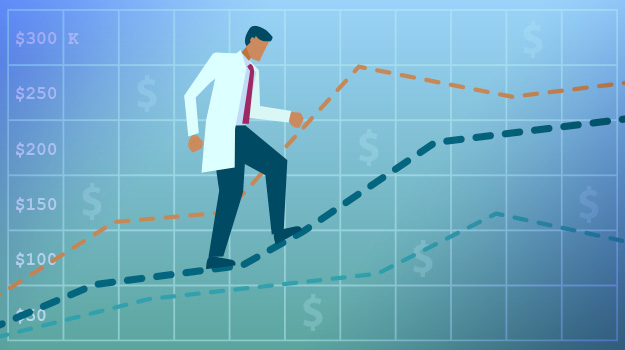Career resources content posted on NEJM CareerCenter is produced by freelance health care writers as an advertising service of NEJM Group, a division of the Massachusetts Medical Society and should not be construed as coming from, or representing the views of, the New England Journal of Medicine, NEJM Group, or the Massachusetts Medical Society
Compensation is holding steady or rising, but the pandemic effects and practices’ declining revenues will likely have an effect going forward
After a stellar run of rising compensation for primary care physicians (PCPs) for several years running, the news is that compensation is still going up — between 2.6% and 4.5% depending on the survey — even if there are clouds on the horizon. Demand has prompted the steady increases, approaching 10 percent overall between 2015 and 2019, and although that demand persists for primary care physicians (PCPs), there’s an elephant in the room now that’s likely to flatten compensation: the pandemic and its attendant effect on practice and hospital revenues.
“The question is, how do you create resiliency in an organization and retain the ability to keep paying rising compensation when revenues are going down? Unless you’re Houdini, in this [financial] environment, you’re going to be paying more and bringing in less revenue to cover operations,” said Fred Horton, president of American Medical Group Association Consulting (AMGA Consulting). “That’s the big challenge going forward: how to honor sustainable physician compensation to the possible detriment of the organization.”
Even if PCP compensation flattens, the pay increases of recent years suggest that organizations recognize the value of primary care in the overall scheme of care delivery. In the AMGA 2020 Medical Group Compensation and Productivity Survey, based on 2019 data and including data from 317 primarily large groups, median compensation across the primary care specialties of family medicine, internal medicine, and pediatrics rose 4.5%. The breakdown across the primary care specialties was as follows:
AMGA—family medicine median compensation: $269,868, up from $260,108 in 2018
AMGA—internal medicine median compensation: $288,697, up from $273,254
AMGA—pediatrics and adolescent medicine median compensation: $257,432, up from $245,043
The Medical Group Management Association’s annual Provider Compensation and Production Report, which included data from more than 168,000 physicians and nonphysician providers, found an average increase of 2.6% in primary care total compensation from 2018 to 2019, to $273,437. Here’s that breakdown, from MGMA’s 2020 DataDive Provider Compensation Report:
MGMA—family medicine average total compensation: $258,947, down slightly from $268,954 in 2018
MGMA—internal medicine average total compensation: $268,658, up from $258,323 in 2018
MGMA—pediatrics (general) average total compensation: $232,409, essentially flat compared with $232,701 in 2018
Although regional compensation variations are generally less pronounced than they were five or 10 years ago, because most organizations consider national data when setting their compensation structures, the MGMA survey did find some notable differences between the Eastern region (with a median of $257,757) compared to the other regions: $273,578 in the Midwest, $276,654 in the Southern region, and $279,626 in the Western region. “Compensation for primary care providers is pretty consistent across each of the regions,” said Andrew Swanson, MBA, vice president of industry insights for MGMA. “The difference between the highest paying region (Western) compared to lowest paying region (Eastern) is just over $20,000.”
The Medscape 2020 Physician Compensation Report, based on survey responses obtained from 17,000 physicians before the pandemic, found a 2.5% average increase in primary care compensation compared to 2019, from $237,000 to $245,000. In the breakdown, family medicine average compensation was $232,000, internal medicine $251,000, and pediatrics $232,000. Interestingly, 58 percent of PCPs surveyed reported receiving incentive bonuses over the year, at an average of $26,000.
Productivity mostly flat in primary care
The trend toward rising work relative value units (W-RVUs), the primary measure of how hard physicians work, appears to be leveling off. The MGMA’s most recent survey found RVUs essentially unchanged from 2018 to 2019 across all primary care specialties. Median W-RVUs sector wide were 4,847 in 2019, a negligible difference of -0.27% from the previous year. The breakdown was 4,714 median W-RVUs in family medicine with obstetrics (and 4,936 without), 4,804 in internal medicine, and 4,879 in pediatrics.
The AMGA survey’s findings were similar. Median W-RVUs came in at 4,740 in family medicine, 4,861 in internal medicine, and 5,246 in pediatrics. From a regional standpoint, W-RVUs were highest in the South and East (in both regions, median W-RVUs topped 5,000 in all three primary care specialties) and lower (below 5,000) in the West and North. The exception was pediatrics, where median RVUs were the highest of all the primary care specialties in all four regions, topping out at 5,676 in the South. “The West was highest in every metric, from total cash compensation to total RVUs,” Mr. Horton said. “That’s not surprising, really, because the region includes some of the highest cost-of-living ZIP codes in the country and that environment also has more capitation — covered lives and risk contracts — than the other regions. In addition, in many of those organizations, [physician] positions are salaried,” Mr. Horton said.
As an indicator of overall primary care physician productivity to organizations’ revenues, it’s worth noting, Mr. Horton pointed out, that while compensation per W-RVU was up 2.6% in 2019, compared to the prior year, collections per RVU dropped by 1.6%. “This is the biggest gap that we saw in all of the specialties, which clearly puts some pressure on organizations going forward,” he said.
The MGMA’s survey found essentially the same trend: For most primary care specialties, compensation increases appear to be outpacing increases in productivity. “There have been concerns about physician shortages, which could be one explanation for higher compensation rates compared to productivity,” said Andrew Swanson, MBA, vice president of industry insights for MGMA.
What was surprising in AMGA’s findings, is that the long-expected significant shift from paying physicians on value rather than predominately on volume still isn’t gaining much traction in the marketplace. In fact, the percentage of physician compensation paid out based on value actually declined slightly in 2019, to 7.6% from 7.8% in 2018. “There’s been a lot of focus on getting more value in [physician care], but that shift is occurring more slowly than we anticipated,” he said.
Gauging pandemic’s effect on compensation
Although the MGMA declined to predict the effects of the pandemic and associated economic conditions and the drop in health care organizations’ revenues effects on PCPs’ (and other physicians’) compensation in the next few years, citing fluctuating economic conditions, the organization is following the situation closely. In MGMA’s 2020 Monthly Survey, which captures compensation and productivity-level information on a monthly basis, preliminary findings showed dips in compensation in April and a slow rebounding in the following months. Not unexpectedly, the drops in provider productivity in April were much more significant than the drop in compensation, MGMA data analysts reported, and rebounding of productivity has been slower as well. Overall, according to MGMA’s recent COVID-19 financial impact report, practices reported an average 55 percent decline in revenue in the early months of the pandemic and many were forced to furlough medical staff.
“COVID-19 has had a dramatic impact on the health care industry with productivity halting for many medical practices. Compensation models will look different in the near future based on shifting productivity and demands on physicians and the industry overall,” said Halee Fischer-Wright, MD, MGMA’s president and chief executive officer.
In a July 2020 Hospital Finance Podcast on the effects of the pandemic on physician compensation, Zachary Hartshell, a principal at SullivanCotter, which conducts annual surveys on physician compensation, reported that relatively few — less than 10 percent — of organizations surveyed had actually implemented wholesale furloughs or layoffs. Instead, SullivanCotter found that organizations making adjustments to address revenue declines were instead reducing compensation, shrinking benefit plans, or opting for temporary furloughs to ride out the drop in patient volumes.
Of course, it’s not all doom and gloom out there, Mr. Horton reminds physicians. The pandemic will pass, organizations will always need skilled PCPs, and physicians will still command good incomes. He noted that the starting salaries for PCPs reported in the latest AMGA survey illustrate the high demand for physicians in that sector. Compared to 2018, starting compensation for internists was up 5.7%, and for family medicine physicians, 3.7%, and pediatricians, 5.1%. Even if the pandemic puts downward pressure on PCP compensation for a while, and organizations will have to adjust accordingly, he said, PCPs should be optimistic overall about their important role in health care delivery, regardless of economic conditions.
In the interim and going forward, to enable flexibility in physician pay structures, Mr. Horton urges organizations to set a component of compensation based on organizations’ financial performance, and he strongly recommends that PCPs get involved in financial decision-making where they practice. “Physicians should focus on organizations that will include them in financial decision-making, not insulate them from financial reality,” he said.
When they’re considering primary care practice opportunities during this uncertain time, Mr. Horton added, physicians shouldn’t be afraid to ask pointed questions about the organization’s financial foundation and its ability and approach to weathering potentially significant upheaval, as the country experienced this year. “Physicians might ask, for example, what happened with patient volumes and how compensation was handled during the first wave of the pandemic and what the organization’s compensation committee has planned in the event of another major disruption,” Mr. Horton said.
Although PCP hiring also took a downturn in the wake of the pandemic, not surprisingly, there’s a general sense that the overall hiring market remains strong because of the underlying factors, according to Merritt Hawkins, one of the country’s largest physician recruiting firms. “The continued impact of COVID-19 makes looking into the future a difficult proposition. However, it’s clear that most of the fundamental supply and demand factors driving compensation in primary care remain in place,” said Tom Florence, an executive vice president at Merritt Hawkins. He cites the aging US population and high prevalence of chronic disease, as well as the growing need for preventive care that’s been sidelined temporarily during the pandemic. “Sooner or later, a backlog of sick patients will need to be addressed. In the short term, COVID-19 reduced demand for primary care doctors and therefore inhibited salary offers, but the underlying factors that drive demand for primary care physicians remain intact,” he said. “I think that primary care physicians can be optimistic that practice offers will remain abundant and compensation levels will hold.”
Urgent care’s boom spurs substantial compensation increases
One of the bright spots on the compensation horizon in recent years has been urgent care, a relatively new specialty that’s seen a big increase in earnings as the model’s prevalence grows. As health systems have newly implemented or expanded their urgent care presence and a slew of newcomer standalone organizations have entered the urgent care market, the specialty has become a darling of sorts in the health care sector. And that is increasing demand for those physicians and, in turn, higher compensation.
In the 2020 MGMA survey, urgent care physicians were No. 2 in terms of their compensation increase year over year, with a jump from a median of $259,661 in 2018 to $277,393 in 2019, a 6.83% increase. It’s worth noting the urgent care physicians worked hard to get the pay hike, with an 8.26% in W-RVUs compared to the previous year. According to MGMA data analysts, the compensation and productivity increases, 15.44% from 2015 to 2019 (compensation) and 12.44% (W-RVUs) might be attributed primarily to market dynamics in recent years. “We’ve seen sizable increases in both physician compensation and productivity in urgent care, which could be indicative of its wider use,” Mr. Swanson said.
The AMGA’s survey found even higher compensation levels in urgent care. Median compensation came in at $295,605 in the 2020 survey, up from $283,787 in the 2019 survey — a substantial increase that occurred without an increase in W-RVUs, which remained flat at 4,895 in 2019. Since 2017, median urgent care compensation has increased by nearly $30,000, far more than for many other nonsurgical specialties.







